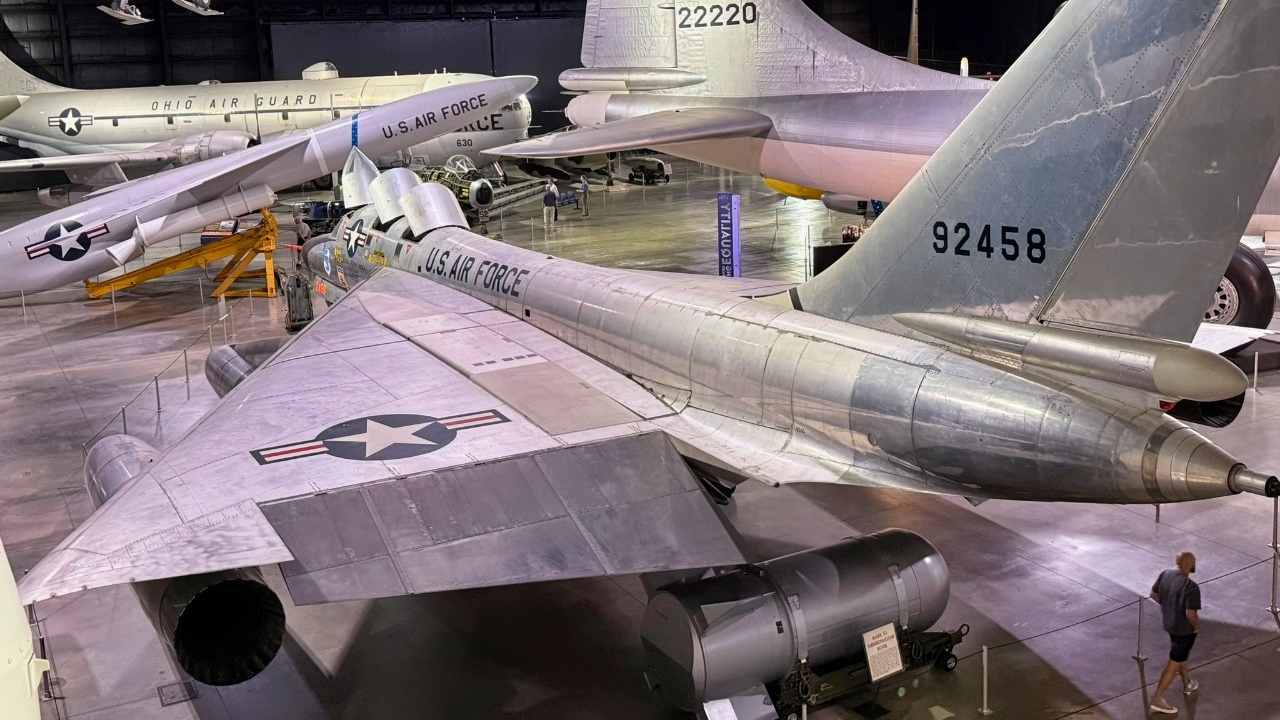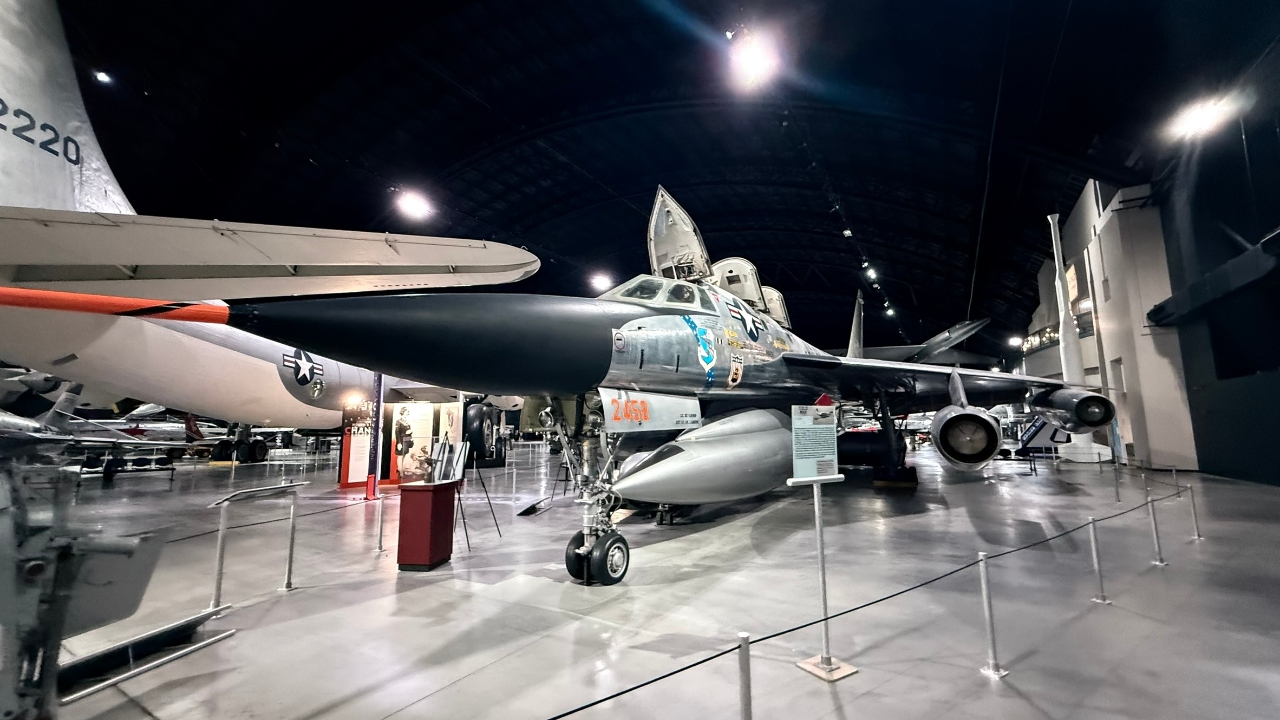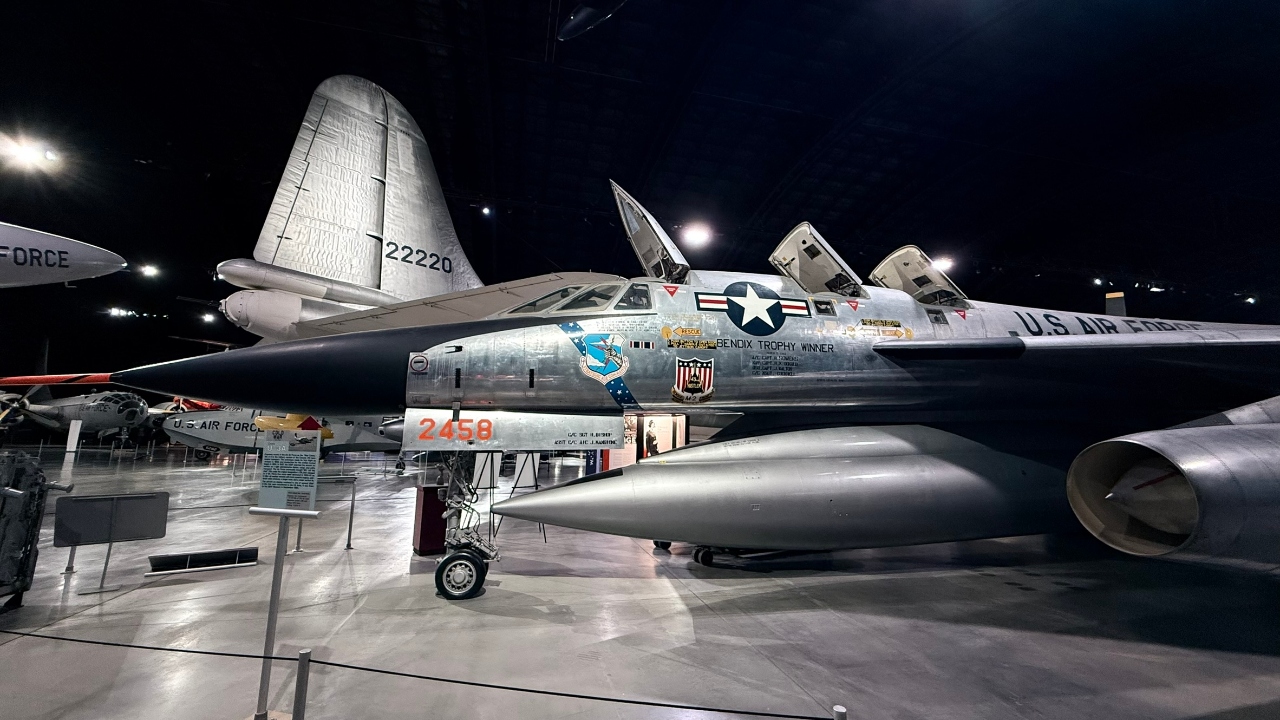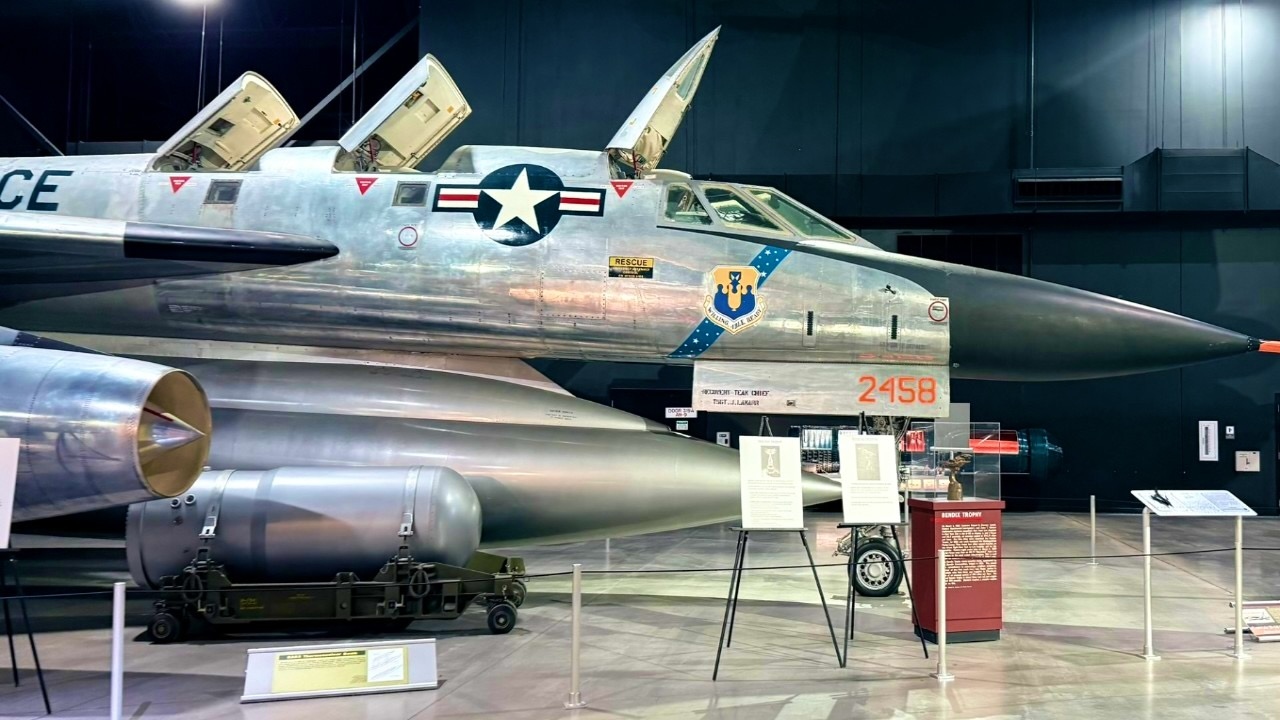Key Points and Summary – The B-58 Hustler was the world’s first operational Mach 2 bomber, built when the Air Force believed speed and altitude could outrun Soviet defenses.
-Entering service in 1960, it paired a slim delta wing and four J79s with a centerline pod that combined fuel and a nuclear weapon.
-It set headline-grabbing records, stood nuclear alert, and demanded exacting maintenance—but never fought in combat.
-As surface-to-air missiles proliferated, strategy shifted to low-level penetration, erasing the B-58’s range advantage and inflating costs.
-Retired in 1970, the B-58 Hustler still matters for its engineering firsts: sustained Mach-2 operations, novel materials, advanced avionics, and life-saving ejection capsules.
BONUS – I was able to see the B-58 Hustler up close when I visited the U.S. Air Force Museum outside of Dayton, Ohio this past July. All of the videos and photos from that visit are included in this article.
The B-58 Hustler: Mach 2 Pathfinder, Costly Pioneer, Enduring Lesson
The early Cold War produced a brutal math problem for Strategic Air Command: radar coverage and interceptor performance were improving faster than subsonic bombers could.
The answer, circa the mid-1950s, was to outrun the danger.
If a bomber could cruise above 50,000 feet and dash at Mach 2, it could cross the deadliest belts of Soviet air defenses before fighters or missiles could react. That doctrine—speed plus altitude equals survival—drove a requirement for a purpose-built supersonic nuclear bomber.

More B-58 Hustler Bomber. Image Credit: Harry J. Kazianis/National Security Journal.
Convair’s solution became the B-58 Hustler: a svelte, stainless-steel honeycomb delta with four powerful turbojets.
It was conceived as a specialist, not a do-everything truck. Its single focus was to carry a nuclear weapon across an ocean, pierce the threat ring at very high speed, and live to turn for home.
Well, at least that was the idea.
A Weapon System Where Form Followed Mission
Everything about the Hustler’s shape served that sprint. The slender fuselage minimized drag; the delta wing offered stability at speed and space for fuel; four under-wing J79s delivered the thrust to climb and sustain supersonic flight. Instead of a cavernous bomb bay, the B-58 typically used a centerline pod that combined fuel and a nuclear store in a jettisonable package. Later, under-wing pylons allowed additional weapons, but the design center never shifted far from nuclear delivery.
The crew of three—pilot, navigator/bombardier, and defensive systems operator—sat in tandem, each under a separate clamshell canopy. High-speed escape was a killer in early tests; the solution was a self-contained ejection capsule that wrapped around a crewmember during ejection, protecting against windblast and debris. For last-ditch defense, the Hustler mounted a radar-aimed tail gun—a small sting on a very fast scorpion.

Top of B-58 Hustler Bomber. Image Credit: Harry J. Kazianis/National Security Journal.
This refinement came with a price. The stainless-steel honeycomb structure and skin that tolerated aerodynamic heating also made the jet maintenance-intensive. The Hustler demanded meticulous workmanship on the ramp and in depots—and rewarded it with performance no other bomber could touch.
Operational History: Alert Pads, Trophies, And A Steep Learning Curve
The B-58 joined frontline service in 1960, equipping two Strategic Air Command wings. Crews pulled nuclear alert under chrome-polished shelters and practiced long-range profiles that culminated in high-altitude, high-speed dashes. In peacetime, the jet doubled as a public ambassador for supersonic credibility, streaking across continents to shatter speed and time-distance records. The most famous day belonged to “Cowtown Hustler,” which set coast-to-coast marks and returned with an armful of trophies—proof that the Mach 2 promise wasn’t just a prototype party trick.
But it was a hard airplane to live with. The B-58 had a narrow envelope on approach, exacting procedures, and unforgiving systems for the era. Early mishaps were too frequent, and a small fleet magnified the impact of each loss. Training and maintenance improved safety, yet the learning curve stayed steep.

Side Angle of B-58 U.S. Air Force Museum. Image Credit: Harry J. Kazianis/National Security Journal.
The Strategy Shift That Undid The Theory Of The Case
While the Hustler proved it could outrun the interceptor problem, the missile problem changed the game. By the early 1960s, surface-to-air missiles and radar networks made the high-altitude dash far more hazardous. The Air Force adapted by pushing its bombers to low-level penetration, where terrain masking reduced radar detection and missile effectiveness.
That pivot cut straight across the B-58’s strengths. At low altitude, fuel burn skyrocketed, range collapsed, and the delta frame took a pounding from turbulence and gust loads. The elegant high-hot runner became a thirsty, structure-stressed sprinter slogging through thick air. Meanwhile, other legs of the nuclear triad—ICBMs and SLBMs—offered retaliation without air defenses at all, and more flexible bombers like the B-52 (with stand-off missiles) and later the FB-111A could perform nuclear and conventional missions with lower cost per sortie.
Combat History: A Sprinter That Never Went To War
Despite a high operational tempo, the B-58 never saw combat. It stood alert, exercised across the Atlantic and Pacific, and participated in sonic-boom studies that later informed policy. As the war in Vietnam grew, the Air Force explored conventional roles for the Hustler, but the compromises were brutal: minimal payload when constrained by runway length and temperature, heavy tanker dependence, and accelerated fatigue from low-level profiles. In a conflict that demanded high sortie rates and flexibility, the B-58’s specialized design lost out to more adaptable airframes.

B-58 Hustler in the Air Force Museum. Image Credit: National Security Journal.
B-58 Hustler: Why It Was Retired—Quickly, And Completely
The decision arrived with surprising speed. In 1970, barely a decade after entering service, the entire B-58 fleet was retired by the Air Force. The reasons were cumulative:
Strategy Moved The Goalposts. Low-level tactics and stand-off weapons displaced the high-altitude dash the B-58 Hustler was built for.
Cost And Complexity. The Hustler carried high maintenance hours per flight hour, specialized materials, and depot burdens that a small fleet couldn’t amortize.
Range Reality At Low Altitude. The low-level profile that dodged missiles also gutted range, multiplying tanker requirements.
Narrow Mission Flexibility. Born around nuclear pods and optimized for speed, the B-58 never became a compelling conventional bomber.
The retirement was abrupt but rational: resources flowed to systems that matched the new playbook.

B-58 Hustler Bomber National Security Journal Photo All Rights Reserved.
What The B-58 Got Right—And What It Taught
For an aircraft with such a short career, the Hustler’s technical legacy is outsized.
Sustained Mach 2 Operations: The B-58 proved that a missionized, three-crew bomber could live at Mach numbers once reserved for fighters and research craft, forcing advances in thermal management, sealing, and structure.
Materials and Manufacturing: Its stainless-steel honeycomb drove new factory techniques and repair methods that influenced later aerospace work.
Crew Survival: The encapsulating ejection system saved lives and set a standard for high-speed escape engineering.
Avionics Integration: For its time, the Hustler’s inertial navigation/bombing suite, defensive sensors, and automation were cutting-edge, compressing workload in a cockpit that moved faster than anything SAC had known.
Equally important are the lessons of what didn’t work. The Air Force gained a painful appreciation for the range and fatigue penalties of low-level supersonic flight; for the budget risk of fielding a single-mission thoroughbred; and for the operational value of multirole flexibility when strategies and threats change mid-stream.
A Reputation Shadowed By Risk—In Context
The B-58’s accident rate looms large in its reputation. Many losses came early, at the edges of a new envelope. Over time, standardized procedures, better training, and the ejection capsules improved outcomes, but the narrative stuck: the Hustler was “hard.” That is true—and incomplete. It was also first, and pioneers pay a tax in blood and learning that later crews do not.
The Legacy: A Brilliant Answer To A Question That Changed
How should we judge the Hustler? To be clear, there were some mistakes made on this bomber and some big assumptions about the future of aviation, however…
Not as a failure, and not as a martyr to budget cutters. The B-58 was a brilliant, precise answer to a problem the Air Force genuinely faced in the mid-1950s: break through defenses with speed and altitude. The problem then changed—missiles matured, doctrine shifted low, and the jet’s design purity turned brittle. The service did the sensible thing and moved on.
What remains is a legacy of technology and truth-telling. Technologically, the B-58 pulled bomber design into the supersonic age and left behind tools—materials know-how, escape systems, avionics approaches—that outlived it. Strategically, it taught a lesson that echoes through every next-gen program: before you build a masterpiece to a single metric, ask how the opponent and the environment might move the goalposts.
The B-58 Hustler: A Mach 2 Mistake?
The B-58 Hustler was the first operational Mach-2 bomber, an arrowhead honed for a specific moment. It never dropped a bomb in anger, but it shifted the frontier of what a bomber could be—and at what cost.
Retired young, remembered sharply, the Hustler’s real payload was knowledge: how to manage heat and speed, how to integrate complex systems, how to think about survivability when the sky itself fights back. That is a legacy worth more than record trophies—because future designers still spend it every time they weigh speed, stealth, payload, range, and cost against a threat that refuses to sit still.
About the Author: Harry J. Kazianis
Harry J. Kazianis (@Grecianformula) is Editor-In-Chief and President of National Security Journal. He was the former Senior Director of National Security Affairs at the Center for the National Interest (CFTNI), a foreign policy think tank founded by Richard Nixon based in Washington, DC. Harry has over a decade of experience in think tanks and national security publishing. His ideas have been published in the NY Times, The Washington Post, The Wall Street Journal, CNN, and many other outlets worldwide. He has held positions at CSIS, the Heritage Foundation, the University of Nottingham, and several other institutions related to national security research and studies. He is the former Executive Editor of the National Interest and the Diplomat. He holds a Master’s degree focusing on international affairs from Harvard University.
More Military
Russia’s Su-33 Flanker Fighter Mistake Still Stings
The Navy’s Columbia-Class Submarine Mistake Still Stings
4 Hellfire Missiles, 3 Harpoon Missiles and More: The Navy Couldn’t Sink Its Own Destroyer
The Midway-Class Aircraft Carriers Have A Message for the U.S. Navy
The Essex-Class aircraft Carriers Have A Message for the U.S. Navy











Ronald Nimmo
September 21, 2025 at 6:42 pm
John Denver’s father was a B-58 Hustler pilot who set long distance speed records in the 1960’s that still stand.